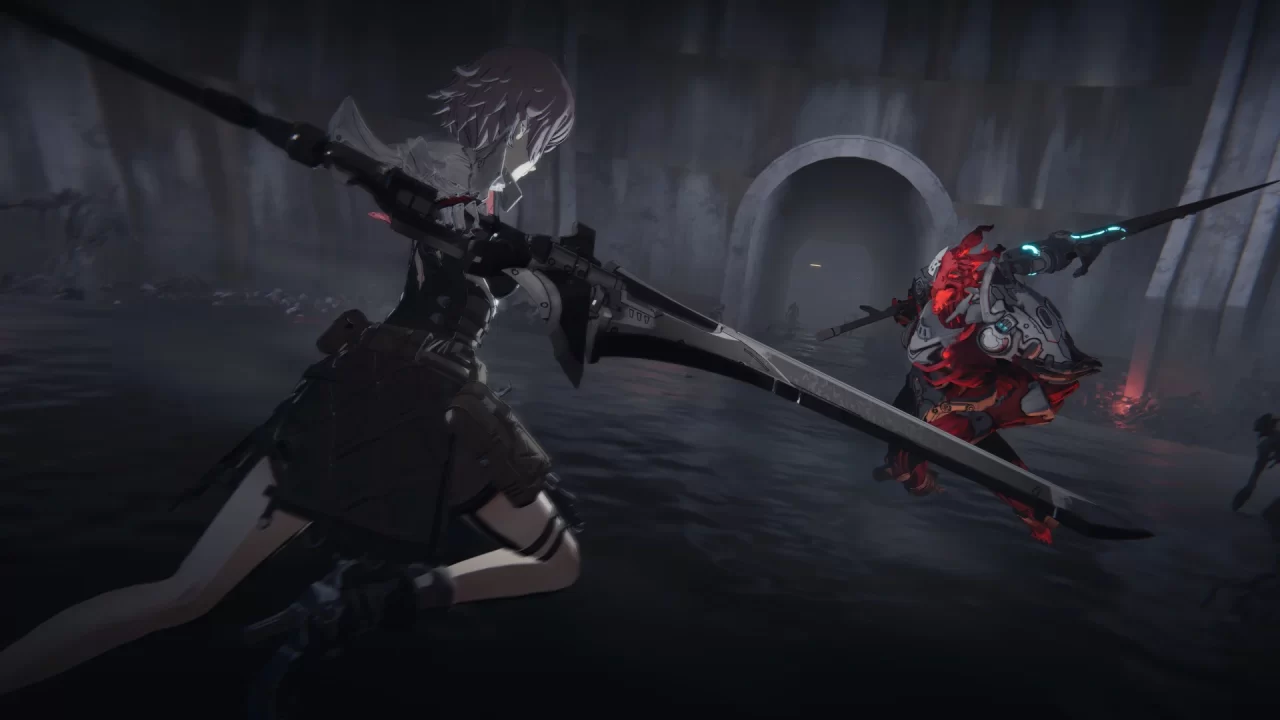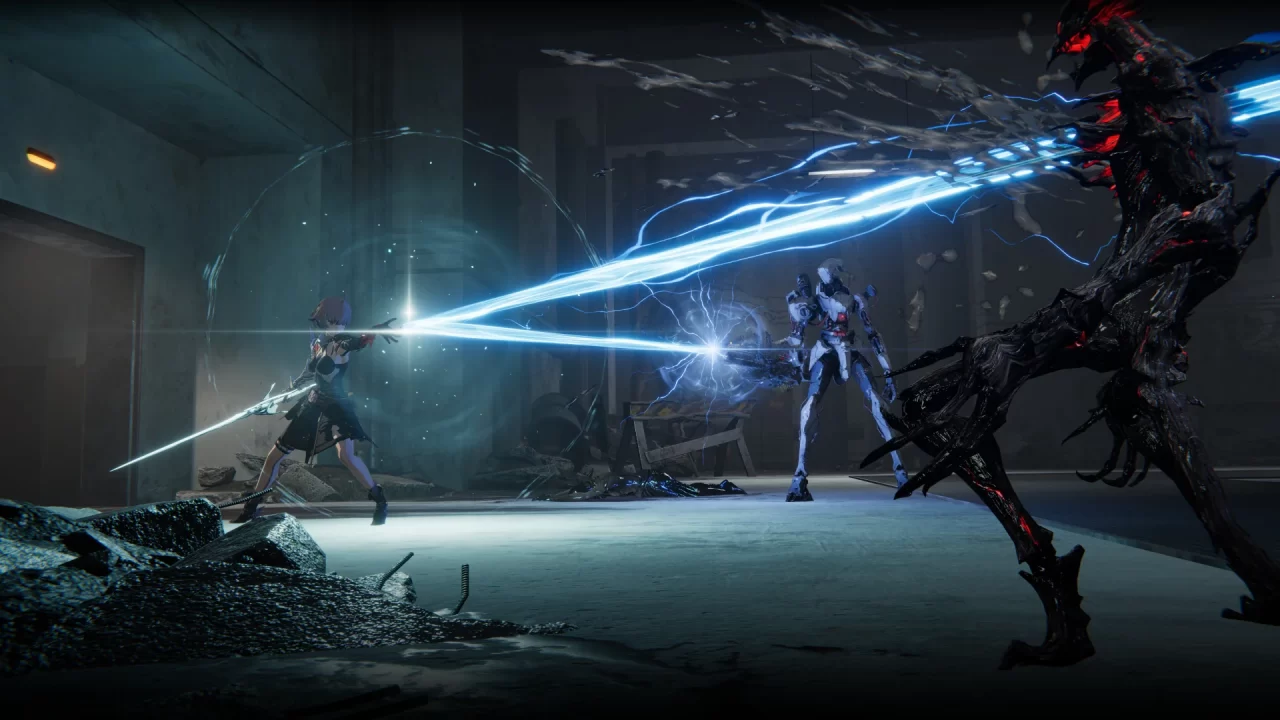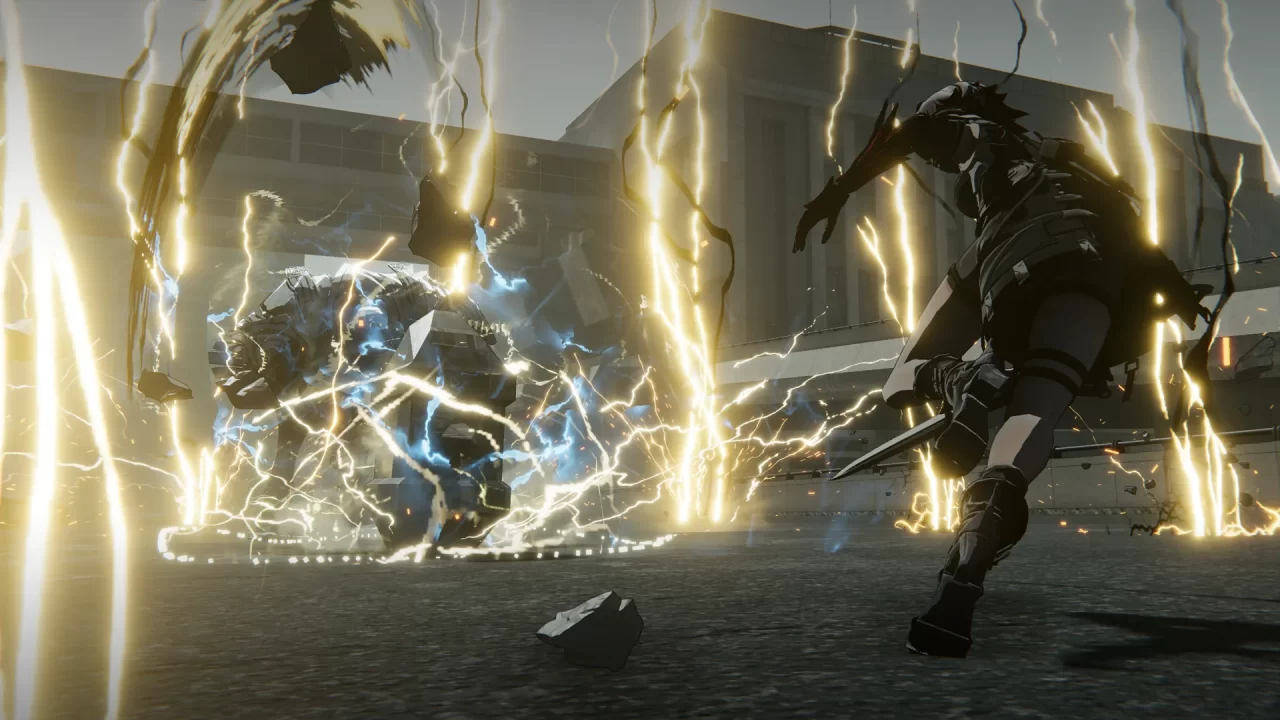If your first thoughts upon seeing the trailers for AI LIMIT are “another one?” I wouldn’t blame you as it is indeed another Souls-like, blending Bloodborne-esque combat and anime aesthetics as its selling point. But what else does it bring to the table besides a surprisingly rare combination of gameplay and art direction within the genre?
Before delving into AI LIMIT‘s spin on the Souls-like formula, I have to commend how good it feels to just play as a baseline. Snappy controls and supremely satisfying feedback for every attack (particularly critical strikes) serve as a strong foundation upon which AI LIMIT conducts its experiments on the well-established tropes of the genre.
The biggest of these is the Sync Rate system, where you manage a gauge that determines damage output and the ability to unleash a variety of powerful spells and weapon arts. Successfully landing hits on enemies increases the gauge, while getting hit or using spells and weapon arts drains it. Maintaining a high sync rate is rewarded with even higher damage, with spells benefitting particularly from the increased damage output. Aggression is the key to maintaining a high sync rate with features like swift light attack combo strings, a combat dash with generous invincibility frames, and infinite stamina facilitating this playstyle.
But the system, while undoubtedly an interesting take on Bloodborne‘s rally mechanic, felt a couple of pieces short of being just right, particularly when grappling with a low gauge. Not only do all your attacks deal less damage in this state, but defensive utility spells lose some of their functionality, with offensive spells becoming entirely unavailable past a certain threshold. Your only real recourse at this point is running away to safety as a fully depleted sync gauge results in a nasty stun, completely inverting the aggressive gameplay AI LIMIT is trying to promote. The system as a whole feels too feast or famine, where a single mistake starts a vicious cycle that can be difficult to break out of in the heat of battle. AI LIMIT does provide some reprieve with the stability stat that reduces the amount of sync rate lost from enemy hits, but managing this can become a bit of a chore in its own right with how the game handles crystals, the leveling currency of the game.
Instead of dropping all your crystals and getting a chance to recover them all by trekking back to your place of death, you instead drop a percentage of your total upon death. An equipable “nucleus” affects the percentage dropped and the number of crystals you acquire from defeating enemies. Initially, this change appeared to be a quality-of-life upgrade compared to most other Souls-likes’ stark all-or-nothing death system. But after the game’s opening hours, this change hardly brought me any peace of mind due to the steep leveling curve and surprisingly expensive vendors. Crystals have a much higher premium than other similar “souls” currency among AI LIMIT‘s peers, making any loss that much more painful. If anything, this made “gotcha” deaths all the more annoying as those were guaranteed currency losses instead of simple mistakes you could recover from. And there are a lot of “gotcha” deaths throughout AI LIMIT.
This doubly pains me because I want to extol the genuinely brilliant level design of AI LIMIT. Havenswell, the ruined city serving as the primary setting for AI LIMIT, isn’t only intelligently designed, but it feels real. Individual levels are intricately crafted with branching paths and perfectly placed shortcuts, with many connecting in ways that show a dedication to worldbuilding usually reserved for more prominent projects. Cleverly hidden pathways lead to genuinely good loot most of the time, though some were a bit of a pain to reach with the horrendous jumping control scheme. Nonetheless, the effort SenseGames put into making the actual traversal as engaging and coherent as possible can be felt at every step of the journey. It’s the unfortunate enemy placements that knock the level design from outstanding down to just okay.
If enemies aren’t busy hiding in crevices and corners waiting to gank you, they’re silently charging up a devastating ranged attack off-screen. They are often placed close to precipitous drops almost with the express purpose of making you fall to your death from the momentum of a missed swing, but you’ll probably end up getting launched off these cliffs anyway with how often AI LIMIT wants you to fight two or more stagger-resistant elite units at a time. This is particularly frustrating given that these elite enemies are engaging fights in their own right, often showcasing the best parts of the sync gauge, the few times you can get them one-on-one. The tax you pay from most of these deaths is frustrating and needlessly bogged down the game’s pace.
Bosses, on the other hand, oddly felt too easy compared to the journey of actually getting to their arenas, primarily due to their tiny health pools. Aggressively fishing for parries into a follow-up attack demolishes their health bar, but they also often lack the unrelenting aggression required to challenge highly defensive playstyles properly. Even towards the lategame, where bosses start to pose as actual threats with their increased damage and speed, I was surprised at how effective it was just to hang back and let my spells do all my work. Admittedly, giving players meaningful build variety while also designing bosses they can’t cheese is a bit of a cursed design problem even FromSoftware hasn’t solved. Still, AI LIMIT nonetheless feels like it’s treading water rather than trying something new in this area.
Speaking of build variety, I was pleasantly surprised at the depth of the offerings available in AI LIMIT. Weapons come in all shapes and sizes, each with a unique weapon skill. Swapping between the two weapons you can equip is fluid even in the heat of battle, thanks to a slick transition that lets you chain together some impressively long attack strings. A wide range of offensive spell choices also enables you to tailor ranged combat to your needs, while your gauntlet provides a variety of utility spells to tinker around with.
Aesthetically speaking, AI LIMIT feels uneven across the board. Though Arissa and the NPCs you encounter sit comfortably within the typical anime-style art direction, their non-combat animations couldn’t quite escape the uncanny valley. This is especially apparent with the rigid facial animations in every cutscene. This uncanniness similarly extends to the visuals of the enemies, as they often clash with those of the environment. Levels are decidedly less stylized than the characters inhabiting them, making any visible enemy pop out in ways that almost feel like a mobile game. The more monstrous and cybernetic mobs fare better in this regard due to their varied silhouettes providing some interesting contrast, but human enemies almost always look like misplaced action figures on a playground.
Despite my gripes with the game, AI LIMIT ultimately was an enjoyable experience. Its faults only peeved me as much as they did because I was having a genuinely good time for most of my 20-hour playthrough. However, the cracks in its gameplay run deep, with aspects like encounter design being persistent issues to the very end. If these aren’t dealbreakers for you, AI LIMIT is a worthwhile time sink; otherwise, it remains a cautious recommendation for anyone else.





